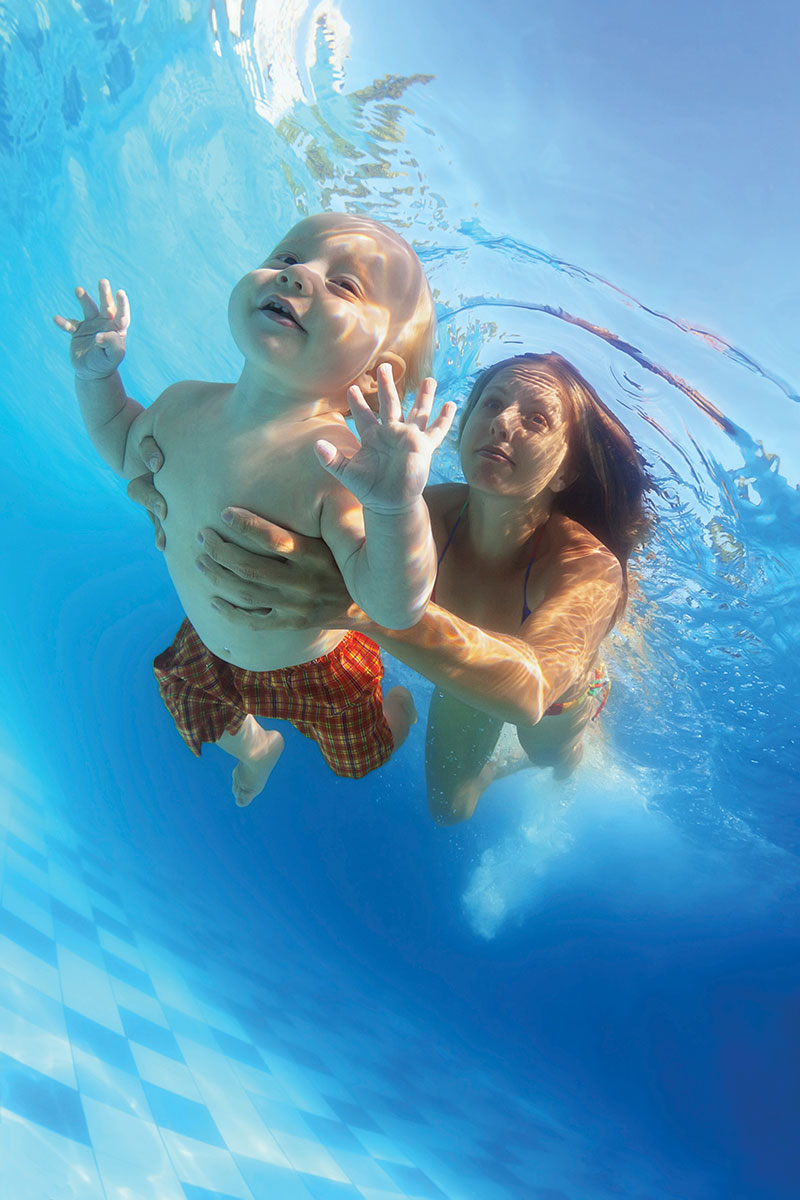 Issaquah resident Tiffany Nance grew up in San Diego, where the ocean was always nearby. She wanted her daughter, Jillian, to love and respect the water, which is why she enrolled in a parent-child swim class when Jillian was 6 months old.
Issaquah resident Tiffany Nance grew up in San Diego, where the ocean was always nearby. She wanted her daughter, Jillian, to love and respect the water, which is why she enrolled in a parent-child swim class when Jillian was 6 months old.
“I was one of those kids in the 1980s who was thrown in the water to fend for herself,” Nance says. “I didn’t want to use that technique for my daughter. I like the idea of being in the water with her, learning together and teaching her to enjoy it.”
Research indicates there are advantages to beginning formal swimming lessons at an early age. In 2010, the American Academy of Pediatrics (AAP) updated its previous recommendations to advise that children as young as 1 can benefit from swimming lessons, depending on individual maturity and ability. It was a significant change in AAP’s longtime recommendation that children commence lessons at age 4.
More research is needed to further define the benefits, but a 2009 study by the Eunice Kennedy Shriver National Institute of Child Health and Human Development indicated that formal swim instruction reduced the risk of drowning by 88 percent in 1- to 4-year-olds.
“It’s a multilayered benefit,” says Jan Bretana, director of the aquatics program at the YMCA of Greater Seattle. “First, it’s a time for children to acclimate and enjoy the water. We later build on that with swimming skills. It’s also a chance to build relationships and bond with their parents or caregivers. And, of course, at every age, it’s an opportunity to teach safety.”
Baby bonding, family fun
Many institutions offer parent-infant water classes before swimming skills can even be learned. The YMCA’s medical advisory board recommends 6 months old as the youngest age for these programs. According to Bretana, this is based on when infants typically have enough head control to avoid accidentally inhaling water, and their ears are developed enough to lessen the risk of infections.
YMCA infant classes include songs and games, blowing bubbles, leg movements and water familiarization. Parent participation is required. Consult with a pediatrician for further advice.
“Water is a great place to bond with your child and learn to read their cues and communication skills,” says Vera Garibaldi, founder of the Puget Sound area’s Waterbabies Aquatic Program.
A 2012 study by Australia’s Griffith Institute for Educational Research studied 7,000 U.S., Australian and New Zealand children who were swimmers at an early age. Results indicated that they reached oral and visual-motor skill milestones faster.
Redmond resident Dinky Aartsen enrolled her children, now 4 and 2 and a half, in water lessons as infants. It was eye-opening to get to know them in a different context.
“Especially having two children, it’s an opportunity to have one-on-one time,” Aartsen says. “My daughter is like a mermaid, and it’s a very freeing experience for her. My son is more cautious.”
Focusing on fun is exactly what experts advise.
“The big thing with the little ones is not to expect too much,” Bretana says. "Meet the child where they are. You want them to enjoy the water and create a lifelong opportunity to be fit and active.”
Safety skills
Safe entry is a focus from the start: waiting to have parental permission to enter the water, and how to return to the wall and hang on. Programs should also include safety techniques while on land such as checking for lifeguards and knowing the dangers of cold water.
Especially in the Northwest, where water is everywhere, it’s never too early to learn safety skills.
“It is important for everyone to know how to swim. No matter what age you are, you are never too old to learn!” Garibaldi says.
At Waterbabies, safe entry is a focus from the start: waiting to have parental permission to enter the water, and how to return to the wall and hang on. Programs should also include safety techniques while on land such as checking for lifeguards and knowing the dangers of cold water.
Nance testifies to the benefits from firsthand experience. When daughter Jillian was 2 years old, she lost her balance and fell off a dock. Thanks to her lessons, the toddler immediately knew to grab the wall.
Water and swim instruction remains equally important even when children start at older ages.
“For school-aged children, it is important to learn safety skills in and around the water. This is a time when kids are attending pool parties and hanging around lakes,” Garibaldi says.
Waterbabies also offers beginner to advanced classes for children up to 10. The YMCA of Greater Seattle offers “Polliwogs” classes for 6-year-old beginners, and Seattle Parks and Recreation also offers a variety of youth lessons.
Questions to consider
There are many types of programs, from one-on-one instruction to group lessons. Regardless of a child’s age or skill level, what should parents consider when selecting a location, instructor or type of class?
“It’s so important to click with your teacher,” Aartsen says, who was previously a Waterbabies instructor. “It’s OK to shop around to find a location and person who accommodates your needs. Don’t be afraid to ask questions.”
Bretana advises parents to attend classes and observe. For children, how much class time is spent actually receiving instruction versus hanging out? Are families offered the opportunity to provide feedback? Ask if it’s possible to talk with prior participants.
“Also, make sure the pool has a lifeguard on duty. If the instructor is teaching swimming, they can’t wear two hats at once. A lifeguard provides overall safety surveillance,” she says.
Of course, parents should inquire about teachers’ certifications and continuing education. The U.S. Swim School Association offers teaching courses, and many organizations require extensive, in-house training. Make sure instructors have basic first-aid and CPR training.
Most important, make swim lessons fun. Not every child will develop into an Olympic swimmer, but parents should encourage basic skills.
Consider a pool’s water temperature. Especially for younger children, a pool that’s too cold hinders their learning.
“If it’s too cold, you start seeing kids getting wiggly and unable to stay still, even becoming upset. It’s a sign they’re uncomfortable,” Bretana says. “In my opinion, the ideal temperature for small children is 86–88 degrees. The very bottom would be 84 degrees.”
Debate continues regarding whether flotation devices are helpful. Like many professionals, Bretana viewed them as a crutch and, for a long time, advised against it.
“I’ve totally thrown that out the window and embraced flotation, but it needs to be the right kind, such as float belts,” she says. “We’ve learned through years of research that it helps build muscle strength so they can better practice and embrace the skills. However, we don’t want to see kids wearing flotation for the entire lesson. That’s bad.”
Most important, make swim lessons fun. Not every child will develop into an Olympic swimmer, but parents should encourage basic skills. Maybe swimming will develop into loving other activities, such as snorkeling or boating.











